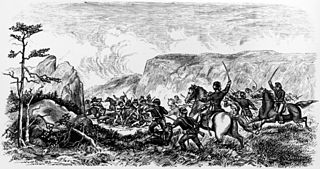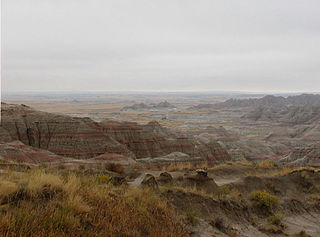 W
WThe Sioux Wars were a series of conflicts between the United States and various subgroups of the Sioux people which occurred in the later half of the 19th century. The earliest conflict came in 1854 when a fight broke out at Fort Laramie in Wyoming, when Sioux warriors killed 31 American soldiers in the Grattan Massacre, and the final came in 1890 during the Ghost Dance War.
 W
WThe Battle of Ash Hollow, also known as the Battle of Blue Water Creek or the Harney Massacre, was an engagement of the First Sioux War, and fought on September 2 and 3, 1855 between United States Army soldiers under Brig. Gen. William S. Harney and a band of the Brulé Lakota along the Platte River in present-day Garden County, Nebraska. In the 20th century, the town of Lewellen, Nebraska, was developed here as a railroad stop.
 W
WThe Dakota War of 1862, also known as the Sioux Uprising, the Dakota Uprising, the Sioux Outbreak of 1862, the Dakota Conflict, the U.S.–Dakota War of 1862 or Little Crow's War, was an armed conflict between the United States and several bands of Dakota. It began on August 17, 1862, along the Minnesota River in southwest Minnesota, four years after its admission as a state. Throughout the late 1850s in the lead-up to the war, treaty violations by the United States and late annuity payments by Indian agents caused increasing hunger and hardship among the Dakota. During the war, the Dakota made extensive attacks on hundreds of settlers and immigrants, which resulted in settler deaths, and caused many to flee the area. This ended with soldiers capturing hundreds of Dakota men and interning their families. A military tribunal quickly tried the men, sentencing 303 to death for their crimes. President Lincoln would later commute the sentence of 264 of them. The mass hanging of 38 Dakota men was conducted on December 26, 1862, in Mankato, Minnesota; it was the largest mass execution in United States history.
 W
WThe Drexel Mission Fight was an armed confrontation between Lakota warriors and the United States Army that took place on the Pine Ridge Indian Reservation in South Dakota on December 30, 1890, the day after the Wounded Knee Massacre. The fight occurred on White Clay Creek approximately 15 miles (24 km) north of Pine Ridge where Lakota were purported to have burned the Catholic Mission.
 W
WFort Dilts was a makeshift sod fort built near Rhame, North Dakota, United States, in September 1864 to fend off attacks by Hunkpapa Sioux Indians led by Sitting Bull upon an encircled wagon train of would-be gold-miners and a small military escort of convalescent soldiers.
 W
WThe Ghost Dance War was an armed conflict in the United States between the Lakota Sioux and the United States government from 1890 until 1891. It involved the Wounded Knee Massacre wherein the 7th Cavalry massacred around 300 unarmed Lakota Sioux, primarily women, children, and elders, at Wounded Knee on December 29, 1890. The Ghost Dance War ended when Sioux leader Kicking Bear surrendered on January 15, 1891.
 W
WThe Grattan Massacre, also known as the Grattan Fight, was the opening engagement of the First Sioux War, fought between United States Army and Lakota Sioux warriors on August 19, 1854. It occurred east of Fort Laramie, Nebraska Territory, in present-day Goshen County, Wyoming.
 W
WThe Great Sioux Reservation was the original area encompassing what are today the various Sioux Indian reservations in South Dakota and Nebraska.
 W
WThe Great Sioux War of 1876, also known as the Black Hills War, was a series of battles and negotiations which occurred in 1876 and 1877 between the Lakota Sioux, Northern Cheyenne, and the United States. The cause of the war was the desire of the U.S. government to obtain ownership of the Black Hills. Gold had been discovered in the Black Hills, settlers began to encroach onto Native American lands, and the Sioux and Cheyenne refused to cede ownership to the U.S. Traditionally, the United States military and historians place the Lakota at the center of the story, especially given their numbers, but some Native Americans believe the Cheyenne were the primary target of the U.S. campaign.
 W
WThe Wounded Knee Massacre, also known as the Battle of Wounded Knee, was a domestic massacre of nearly three hundred Lakota people, by soldiers of the United States Army. It occurred on December 29, 1890, near Wounded Knee Creek on the Lakota Pine Ridge Indian Reservation in the U.S. state of South Dakota, following a botched attempt to disarm the Lakota camp. The previous day, a detachment of the U.S. 7th Cavalry Regiment commanded by Major Samuel M. Whitside intercepted Spotted Elk's band of Miniconjou Lakota and 38 Hunkpapa Lakota near Porcupine Butte and escorted them 5 miles (8.0 km) westward to Wounded Knee Creek, where they made camp. The remainder of the 7th Cavalry Regiment, led by Colonel James W. Forsyth, arrived and surrounded the encampment. The regiment was supported by a battery of four Hotchkiss mountain guns.
 W
WThe Pine Ridge Indian Reservation, also called Pine Ridge Agency, is an Oglala Lakota Indian reservation located in the U.S. state of South Dakota. Originally included within the territory of the Great Sioux Reservation, Pine Ridge was created by the Act of March 2, 1889, 25 Stat. 888. in the southwest corner of South Dakota on the Nebraska border. Today it consists of 3,468.85 sq mi (8,984.3 km2) of land area and is one of the largest reservations in the United States.
 W
WThe Powder River Massacre, part of the Powder River Expedition, occurred on August 17, 1865, and was carried out by United States soldiers and Pawnee scouts against 24 Cheyenne people. The incident occurred near the Powder River in Dakota Territory, in present-day Johnson County, Wyoming.
 W
WThe Powder River Expedition of 1865 also known as the Powder River War or Powder River Invasion, was a large and far-flung military operation of the United States Army against the Lakota Sioux, Cheyenne, and Arapaho Indians in Montana Territory and Dakota Territory. Although soldiers destroyed one Arapaho village and established Fort Connor to protect travelers on the Bozeman Trail, the expedition is considered a failure because it failed to defeat the Indians and secure peace in the region.
 W
WThe Red Cloud Agency was an Indian agency for the Oglala Lakota as well as the Northern Cheyenne and Arapaho, from 1871 to 1878. It was located at three different sites in Wyoming Territory and Nebraska before being moved to South Dakota. It was then renamed the Pine Ridge Reservation.
 W
WRed Cloud's War was an armed conflict between the Lakota, Northern Cheyenne, and Northern Arapaho on one side and the United States in Wyoming and Montana territories from 1866 to 1868. The war was fought over control of the western Powder River Country in present north-central Wyoming. This grassland, rich in buffalo, was traditionally Crow Indian land, but the Lakota had recently taken control. The Crow tribe held the treaty right to the disputed area, according to the major agreement reached at Fort Laramie in 1851. All involved in "Red Cloud's War" were parties in that treaty.
 W
WThe Spirit Lake Massacre was an attack by a Wahpekute band of Santee Sioux on scattered Iowa frontier settlements during a severe winter. Suffering a shortage of food, the renegade chief Inkpaduta led 14 Sioux against the settlements near Okoboji and Spirit lakes in the northwestern territory of Iowa near the Minnesota border, in revenge of the murder of Inkpaduta's brother, Sidominadotah, and Sidominadotah's family by Henry Lott. The Sioux killed 35-40 settlers in their scattered holdings, took four young women captive, and headed north. The youngest captive, Abbie Gardner, was kept a few months before being ransomed in early summer. It was the last Native American attack on settlers in Iowa, but the events increased tensions between the Sioux and settlers in the Minnesota Territory. Nearly 30 years after the events, in 1885 Gardner-Sharp published her memoir, History of the Spirit Lake Massacre and Captivity of Miss Abbie Gardner, which was reprinted several times in small editions. It was one of the last captivity narratives written of European Americans' being held by Native Americans. In 1891, Gardner-Sharp purchased the primitive family cabin and returned home. For the last 30 years of her life, she subsisted on the modest earnings from her book and souvenir sales. The town erected an historical monument to commemorate the attack. The State of Iowa now maintains the park and Abbie Gardner Sharp home site.
 W
WThe Fort Laramie Treaty of 1851 was signed on September 17, 1851 between United States treaty commissioners and representatives of the Cheyenne, Sioux, Arapaho, Crow, Assiniboine, Mandan, Hidatsa, and Arikara Nations. The treaty was an agreement between nine more-or-less independent parties. The treaty set forth traditional territorial claims of the tribes as among themselves.
 W
WThe Treaty of Fort Laramie is an agreement between the United States and the Oglala, Miniconjou, and Brulé bands of Lakota people, Yanktonai Dakota and Arapaho Nation, following the failure of the first Fort Laramie treaty, signed in 1851.
 W
WBy the Treaty of Old Crossing (1863) and the Treaty of Old Crossing (1864), the Pembina and Red Lake bands of the Ojibwe, then known as Chippewa Indians, purportedly ceded to the United States all of their rights to the Red River Valley. On the Minnesota side, the ceded territory included all lands lying west of a line running generally southwest from the Lake of the Woods to Thief Lake, about 30 miles (48 km) west of Red Lake, and then angling southeast to the headwaters of the Wild Rice River near the low-lying divide separating the watershed of the Red River of the North from the watershed of the Mississippi River. On the North Dakota side, the ceded territory included all of the Red River Valley north of the Sheyenne River. The total land area, roughly 127 miles (204 km) wide east to west and 188 miles (303 km) long north to south, consisted of nearly 11,000,000 acres (45,000 km2) of rich prairie land and forests.
 W
WThe Wounded Knee Massacre, also known as the Battle of Wounded Knee, was a domestic massacre of nearly three hundred Lakota people, by soldiers of the United States Army. It occurred on December 29, 1890, near Wounded Knee Creek on the Lakota Pine Ridge Indian Reservation in the U.S. state of South Dakota, following a botched attempt to disarm the Lakota camp. The previous day, a detachment of the U.S. 7th Cavalry Regiment commanded by Major Samuel M. Whitside intercepted Spotted Elk's band of Miniconjou Lakota and 38 Hunkpapa Lakota near Porcupine Butte and escorted them 5 miles (8.0 km) westward to Wounded Knee Creek, where they made camp. The remainder of the 7th Cavalry Regiment, led by Colonel James W. Forsyth, arrived and surrounded the encampment. The regiment was supported by a battery of four Hotchkiss mountain guns.